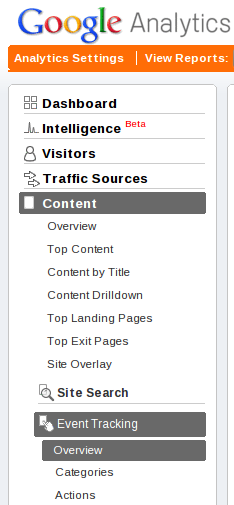Analyser les clicks sur votre Site
Utiliser Google Analytics comme un Pro
Voici comment analyser tous les clics que font vos utilisateurs sur votre blog en incluant google analytics de façon asynchrone.
Dans le html, il faut utiliser jQuery et un fichier que j’ai appelé yga.js :
<script type="text/javascript" src="jquery.js"></script>
<script type="text/javascript" src="yga.js"></script>Voici le contenu du fichier yga.js :
$(document).ready( function() {
// add an event to all link for google analytics
$('a').click(function () {
// tell analytics to save event
try {
var identifier=$(this).attr('id') ;
var href=$(this).attr('href')
var label="";
if ( typeof( identifier ) != 'undefined' ) {
label=label+'[id]:'+identifier
category='JSLink'
}
if ( typeof( href ) != 'undefined' ) {
label=label+' [href]:'+href
if ( href[0] == '#' ) {
category='Anchor';
} else {
category='Link';
}
}
_gaq.push(['_trackEvent', category, 'clicked', label]);
// console.log('[tracked]: ' + category + ' ; clicked ; ' + label );
}
catch (err) {
console.log(err);
}
// pause to allow google script to run
var date = new Date();
var curDate = null;
do {
curDate = new Date();
} while(curDate-date < 300);
});
});
var _gaq = _gaq || [];
_gaq.push(['_setAccount', 'UA-XXXXXXXX-1']);
_gaq.push(['_trackPageview']);
(function() {
var ga = document.createElement('script'); ga.type = 'text/javascript'; ga.async = true;
ga.src = ('https:' == document.location.protocol ? 'https://ssl' : 'http://www') + '.google-analytics.com/ga.js';
var s = document.getElementsByTagName('script')[0]; s.parentNode.insertBefore(ga, s);
})();Remplacez le : UA-XXXXXXXX-1 par votre code google analytics. Maintenant l’installation est finie.
Pour l’utiliser il suffit de se rendre dans google analytics rubrique Content puis Event Tracking comme sur la capture d’écran suivante :

Joyeuse inspection du comportement de vos utilisateurs.
Published on 2010-06-17